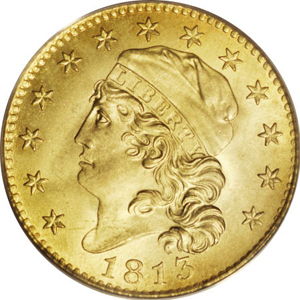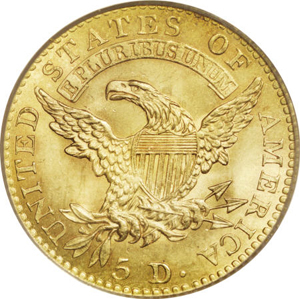Neil S Berman
Expert Numismatist & Rare Coin Dealer
1813 $5 MS66 PCGS. BD-2, R.4.
 In 1813 the half eagle was the only U.S. gold denomination being produced. Gold eagles had not been made since 1804, and quarter eagle production was interrupted from 1808 until 1821. The Capped Head half eagles, produced from 1813 to 1834, were made during a period when widespread melting took place. Most of the coins never circulated, and they frequently went straight from the Mint into the hands of bullion dealers. Some forty thousand pieces of "recent mintage" were destroyed in a single Paris melt in 1831, according to Walter Breen.
In 1813 the half eagle was the only U.S. gold denomination being produced. Gold eagles had not been made since 1804, and quarter eagle production was interrupted from 1808 until 1821. The Capped Head half eagles, produced from 1813 to 1834, were made during a period when widespread melting took place. Most of the coins never circulated, and they frequently went straight from the Mint into the hands of bullion dealers. Some forty thousand pieces of "recent mintage" were destroyed in a single Paris melt in 1831, according to Walter Breen.
The reason for this mass melting of U.S. gold coinage was simple: the Coinage Act of 1792 had established a 15:1 ratio between silver and gold, but by 1813 the ratio in Europe was 16:1 or more. All circulating U.S. gold coins were now worth more than their face value in silver, as bullion dealers swiftly realized. Fifteen ounces of silver would buy one ounce of gold in the United States, but that same ounce of gold would bring sixteen ounces of silver in Paris or London.
The 1813 half eagle is important to collectors for several reasons: First, it is the initial year in the Capped Head series. Second, it is by far the most affordable and obtainable date in the series, a series which few would dispute is the most difficult in all of U.S. numismatics. Of the seventeen major issues (excluding varieties) in this series, only the 1813, 1814/3, 1818, 1820, 1823, and 1826 are offered for sale with any degree of regularity. This means that the "average" Capped Head half eagle issue is a rarity. According to The Encyclopedia of U.S. Gold Coins 1795-1933 (2006): "The Capped Head to Left, Large Diameter type, issued from 1813 to 1829, contains some of the greatest rarities in American numismatics--coins such as the 1822 half eagle (three known), the 1825/4 (two known), the 1815 (at least four known) and the 1829 Large Date. Most of the dates in this series have low mintages, usually below 50,000 coins. The 1820 half eagle has the highest mintage (263,806 coins), and the 1815 has the lowest (635 coins). Some dates, such as the 1819, have a reasonably high mintage (51,723 coins) but remain extremely rare today."
 Approximately six hundred examples of the 1813 half eagle have been encapsulated through the combined efforts of NGC and PCGS; but that figure probably reflects numerous resubmissions over the past twenty years. It is possible, however, that as many as 500 pieces still exist, and perhaps a few more. Many of the known examples have survived in Mint State, including quite a few near-Gems. However, the population drops off dramatically at the Gem level, and any 1813 half eagle in MS65 or better condition is an extreme rarity. Two varieties of the 1813 half eagle are known, and these are identified as Bass Dannreuther-1 (BD-1) and Bass Dannreuther-2 (BD-2). BD-1 is also sometimes known as Miller-119, based on the reference by Robert W. Miller, Sr.; and has the D in the denomination leaning sharply to the left. A second variety, BD-2, has both the 5 and the D in the denomination upright, with the left serifs of D showing evidence of recutting. The BD-1 variety is about twice as common as the BD-2. As both varieties are from the same obverse die, determination of the emission sequence is as simple as comparing die states of the obverse on each of the two varieties. No die cracks have been observed on the BD-1 variety. A thin die crack from the border left of the date to the bust is seen on this example of BD-2, as on a couple of the other known specimens. The appearance of this die crack clearly tells us that the BD-2 variety was struck second.
Approximately six hundred examples of the 1813 half eagle have been encapsulated through the combined efforts of NGC and PCGS; but that figure probably reflects numerous resubmissions over the past twenty years. It is possible, however, that as many as 500 pieces still exist, and perhaps a few more. Many of the known examples have survived in Mint State, including quite a few near-Gems. However, the population drops off dramatically at the Gem level, and any 1813 half eagle in MS65 or better condition is an extreme rarity. Two varieties of the 1813 half eagle are known, and these are identified as Bass Dannreuther-1 (BD-1) and Bass Dannreuther-2 (BD-2). BD-1 is also sometimes known as Miller-119, based on the reference by Robert W. Miller, Sr.; and has the D in the denomination leaning sharply to the left. A second variety, BD-2, has both the 5 and the D in the denomination upright, with the left serifs of D showing evidence of recutting. The BD-1 variety is about twice as common as the BD-2. As both varieties are from the same obverse die, determination of the emission sequence is as simple as comparing die states of the obverse on each of the two varieties. No die cracks have been observed on the BD-1 variety. A thin die crack from the border left of the date to the bust is seen on this example of BD-2, as on a couple of the other known specimens. The appearance of this die crack clearly tells us that the BD-2 variety was struck second.
This Premium Gem is possibly the finest-known example of the date, and almost certainly of the variety. It is sharply struck with all details on both sides exceptionally well detailed. Although the centering is not perfect, the borders on both sides are complete. All of the hair curls on the obverse are well defined, and each of the stars has complete center lines. The reverse detail is similarly sharp, with the sole exception of the eagle's claws which are a bit bluntly defined. The surfaces are frosty and fully lustrous with lovely yellow-gold color. Light orange toning is visible on the reverse, and near the obverse periphery, and adds to the overall aesthetic appeal of the piece.
This was the first year of issue for the Capped Head design type, modified from the Draped Bust type introduced by John Reich in 1807. According to Walter Breen, writing in 1966: "Obverse shows head of Liberty, without drapery, on a much larger scale than previous profiles. The cap is much more close-fitting. Curls somewhat resemble those on the 1807-12 design but are not identical. Rounded truncation of the bust shows. This head continued to be used until 1829, in which year modifications of design appeared in the new hub introduced by William Kneass. Stars are no longer divided 7X6 but rather form a continuous line around and above head. Dates are larger than on previous years except for 1810 and 1812. The eagle is also different in minor details, most noticeably at wing feathers nearest his body; shield is smaller, arrows much wider and more spread apart, motto letters taller, claws much larger and the individual ones more spread apart, leaves longer and wider, etc. Border denticulation on both sides is much more coarse than formerly."
From the famous Garrett Collection that was originally formed by T. Harrison Garrett in the latter 19th century and bequeathed to his son, Robert. As Robert Garrett was more of an art aficionado, and his brother John Work Garrett was more the numismatist, the two traded collections. After John Work Garrett passed away, his widow willed the collection to the Johns Hopkins University in Baltimore. Eventually the collection was sold in a series of auctions, the first in 1976 and the others from 1979 to 1981. Population: 1 in 66, 0 finer (11/06). Ex: Garrett Collection; Johns Hopkins University (Bowers and Ruddy, 11/79), lot 458; Gold Rush Collection (Heritage, 1/05), lot 30045. Heritage sold this coin for $316,250.00 in January.
© 2006 Heritage Galleries. Used with permission of Steve Ivy and Heritage Galleries.